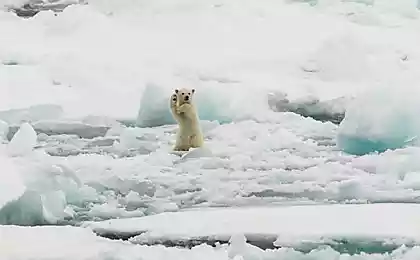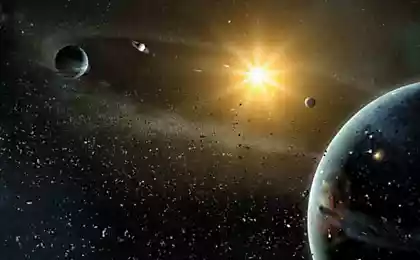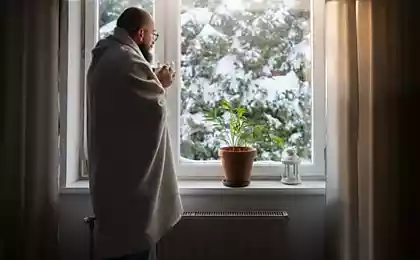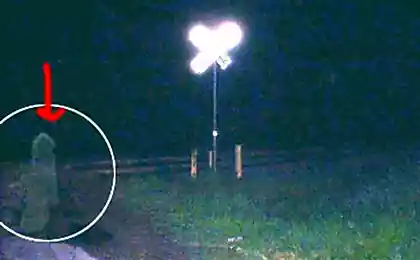864
10 amazing natural phenomena, recorded on tape
Miracles prirody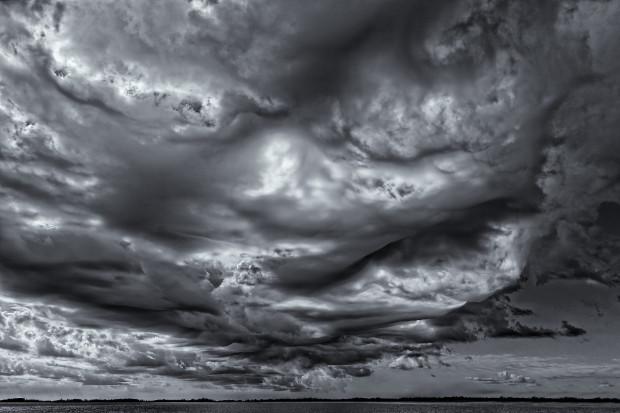
Nature and then find ways to show us how we are incredibly small compared even to the planet. The closer you look, the more you realize that some of the things and phenomena that often seem to be something self-evident, in fact, truly amazing. And now we are still able to photograph and film them, to see all the wonders of nature.
1. Sea Foam
Sea foam is obtained from sea water with a high concentration of organic substances, usually after surf. Usually it looks like only a thin line of foam at the waterline, but the foam is sometimes so much that it breaks out of the water and invades the land.
Large sea foam can occur for several reasons, but most of all - because of algae bloom. When near the shore there is a huge number of autotrophs, the decaying algae, combined with the surf can be "whipped" into the foam. For the most part, this foam is harmless, but in reality it is a good indicator of normality ocean ecosystems.
But in rare cases, a large amount of foam is dangerous. Some colors (like dinoflagellates Karenia brevis) can even distribute algal toxins that can irritate the eyes and the respiratory system of humans and animals, resulting in a bird or marine life even die.
2. Dendritic crystals
Dendrites - are crystals that form a repeating pattern that makes them look like trees. From the viewpoint of Mineralogy, dendritic crystal formation occur whenever rich in iron and manganese, the water flows along the cracks, and various types of rock strata. Chemically dendrite - is any crystal growth during divisible into two parts.
Fractal patterns give dendrites startling resemblance to the trees. It is wonderfully combined with the beauty of winter - ice crystals appear. As such they become, when moisture from the surrounding atmosphere condenses almost immediately. The result is a pattern that will be repeated until such time as the ambient conditions do not change. The growth of dendritic ice crystals similar to the growth of a living being: with the passage of time, the crystals become infinitely more complicated.
3. Island wavy oblaka
Islands can create waves in the sky. Ocean Beach - not too serious obstacle for the emerging wind on the water. This means that the people in the boat will feel a stronger wind than in the city center among the many buildings, cars, trees and other objects that interfere with air flow.
When the strong air currents from the open water on the way encounter the island, the wind or enhanced, or passes over the island - about the air travels up along the windshield of the car. And so the air can create spectacular waves in the clouds, the shape of which depends on the place where the wind changed direction.
In 2009, NASA managed to take some photos of such a massive phenomenon in the South Sandwich Islands.
4. Explosive lakes
Explosive lakes - a natural phenomenon resulting from the unusually high concentration of CO2 or any methane in the water. During the "explosive" event can be seen on the surface of the lake there is a lot of bubbles - this gas is discharged from the depths. But over the lake at the same time formed a dangerous gas cloud, which could prove fatal for those who will be on the coast.
This phenomenon was first learned in 1984, when the lake in Cameroon exploded and broke out the gas cloud that killed 37 people. Other lake in Cameroon exploded in 1986, killing 1,700 people.
In the video you can see how from a frozen lake in the world sees a combustible methane. This shows not only how dangerous would lake without ice, and that the concentration of methane in the lake can be reduced - to make sure that the gas released to the atmosphere as CO2. Although CO2 is also a greenhouse gas, methane releases 25 times more heat, which means that the people on the video are lit torches to prevent the possibility of fire.
5. undulating hilly clouds (asperatusy) < br />
Wavy-hilly clouds in a separate view of clouds relatively recently, just 30 years ago. Such clouds in the sky look like ocean waves with their constant unidirectional movement, and although they look quite menacing, they scattered themselves, without storm or other violence of elements.
Since they have opened recently, scientists do not know yet exactly the cause. Research is being conducted - scientists want to find out exactly what conditions are necessary for the formation of asperatusov.
Wavy-hilly clouds often occur in the Great Plains of North America. To bring them into a separate category was offered only in 2009, the year, and if the proposal is accepted, it will be the first asperatusy "new" clouds over the past 50 years.
6. Ice Tsunami
Ice tsunami occurs when strong wind or ocean currents allow solid and partly melted ice accumulate at the water's edge, and eventually move on the ground. Imagine looking at a video of the glacier advance at fast - just like ice tsunami and looks.
In fact, the same mechanism as that of the iceberg. Strong ocean currents allow icebergs drifting on the water, and strong winds could allow the ice to overcome the friction of the ground and start to move. Witnesses compared the sound of the ice tsunami slammed the wheels of the train, and the sound of thunder at the same time beating countless windows at once. Generally, such motion causes damage to the ice at standing water homes and trees. During the winter in northern areas, such as Canada, are often warnings of ice accumulation is transmitted on television and radio, along with warnings about floods.
7. Blue «lava»
Kawah Ijen volcano on Indonesia was recently filmed an unusual phenomenon: people have noticed that flows from the crater is not an ordinary lava - it was blue.
Blue - is a consequence of coming out of the cracks volcanic sulfur gas, rather than lava. When the high pressure gas meets with air, it burns, and some of the sulfur actually condenses and becomes a liquid, and then red-hot stream continues to flow along the slopes of the same, as does the lava.
Although this phenomenon reported infrequently, molten sulfur volcanic fumaroles - a common phenomenon. The melting point of sulfur is quite low, and the temperature in the crater of the volcano, and next to it are often significantly higher, while the blue "lava" appears where it happens.
8. Effect Leidenfrost
Most people are aware that the water evaporates during heating. Those who once boiled water in a pan, probably noticed that at a sufficient temperature water bubbles will float to the surface in the form of droplets and evaporate more slowly. This phenomenon is called Leidenfrost effect, and it can cause fluid to move uphill. In the video, the physics of the University of Bath, this effect is used to creatively move the droplets of water.
When the liquid comes in contact with the body whose temperature is considerably above the boiling point of liquid around it there is an insulating layer of vapor. This layer prevents the fluid from rapid boiling. This contributes to the low thermal conductivity of steam - the rate of heat transfer between the hot surface and the water drop is slowing sharply.
9. Snow rollers
Snow rollers - it's natural spheres or cylinders of snow. They appear among various landscapes with the right consistency of snow. Most often snowy ridges occur in the hills - they create a breeze. When the wind sweeps drifting snow, it collects more snow, and then rolls them into rolls just as we roll down balls for the snowman. It is very rare, because for the emergence of natural snowball need to exact compliance with the set conditions.
Meteorologists say that the formation of snow rollers already fallen snow on the ground should be firm enough to new falling snow stick together not with him. In this case, the right mix of fresh snow, strong wind and an open space can generate snow rollers. And if the snow from growing on the steep slope of trees suddenly falls down, it can "push" snow roller and the roll.
10. Asphalt lakes
Lake Pitch Lake in Trinidad and Tobago - a rather strange phenomenon. People discovered it in 1595, the year and immediately realized how useful Marsh resin. However, the origin of the lake have been very few studies. Some scientists believe that it was the result of two faults that are encountered on the surface of the earth made of oil. However, this is only speculation - certainly not known. Prolonged contact with air at the surface allows more light elements oil does not evaporate, thereby forming the asphalt.
La Brea Peach is the largest asphalt lake in the world. This is a great economic resource for the people of Trinidad and Tobago. From the Lake of asphalt can be made on the export of anti-corrosion black paint, insulating compound, sealant, car mats and many other useful things.
via factroom.ru

Nature and then find ways to show us how we are incredibly small compared even to the planet. The closer you look, the more you realize that some of the things and phenomena that often seem to be something self-evident, in fact, truly amazing. And now we are still able to photograph and film them, to see all the wonders of nature.
1. Sea Foam
Sea foam is obtained from sea water with a high concentration of organic substances, usually after surf. Usually it looks like only a thin line of foam at the waterline, but the foam is sometimes so much that it breaks out of the water and invades the land.
Large sea foam can occur for several reasons, but most of all - because of algae bloom. When near the shore there is a huge number of autotrophs, the decaying algae, combined with the surf can be "whipped" into the foam. For the most part, this foam is harmless, but in reality it is a good indicator of normality ocean ecosystems.
But in rare cases, a large amount of foam is dangerous. Some colors (like dinoflagellates Karenia brevis) can even distribute algal toxins that can irritate the eyes and the respiratory system of humans and animals, resulting in a bird or marine life even die.
2. Dendritic crystals
Dendrites - are crystals that form a repeating pattern that makes them look like trees. From the viewpoint of Mineralogy, dendritic crystal formation occur whenever rich in iron and manganese, the water flows along the cracks, and various types of rock strata. Chemically dendrite - is any crystal growth during divisible into two parts.
Fractal patterns give dendrites startling resemblance to the trees. It is wonderfully combined with the beauty of winter - ice crystals appear. As such they become, when moisture from the surrounding atmosphere condenses almost immediately. The result is a pattern that will be repeated until such time as the ambient conditions do not change. The growth of dendritic ice crystals similar to the growth of a living being: with the passage of time, the crystals become infinitely more complicated.
3. Island wavy oblaka

Islands can create waves in the sky. Ocean Beach - not too serious obstacle for the emerging wind on the water. This means that the people in the boat will feel a stronger wind than in the city center among the many buildings, cars, trees and other objects that interfere with air flow.
When the strong air currents from the open water on the way encounter the island, the wind or enhanced, or passes over the island - about the air travels up along the windshield of the car. And so the air can create spectacular waves in the clouds, the shape of which depends on the place where the wind changed direction.
In 2009, NASA managed to take some photos of such a massive phenomenon in the South Sandwich Islands.
4. Explosive lakes
Explosive lakes - a natural phenomenon resulting from the unusually high concentration of CO2 or any methane in the water. During the "explosive" event can be seen on the surface of the lake there is a lot of bubbles - this gas is discharged from the depths. But over the lake at the same time formed a dangerous gas cloud, which could prove fatal for those who will be on the coast.
This phenomenon was first learned in 1984, when the lake in Cameroon exploded and broke out the gas cloud that killed 37 people. Other lake in Cameroon exploded in 1986, killing 1,700 people.
In the video you can see how from a frozen lake in the world sees a combustible methane. This shows not only how dangerous would lake without ice, and that the concentration of methane in the lake can be reduced - to make sure that the gas released to the atmosphere as CO2. Although CO2 is also a greenhouse gas, methane releases 25 times more heat, which means that the people on the video are lit torches to prevent the possibility of fire.
5. undulating hilly clouds (asperatusy) < br />
Wavy-hilly clouds in a separate view of clouds relatively recently, just 30 years ago. Such clouds in the sky look like ocean waves with their constant unidirectional movement, and although they look quite menacing, they scattered themselves, without storm or other violence of elements.
Since they have opened recently, scientists do not know yet exactly the cause. Research is being conducted - scientists want to find out exactly what conditions are necessary for the formation of asperatusov.
Wavy-hilly clouds often occur in the Great Plains of North America. To bring them into a separate category was offered only in 2009, the year, and if the proposal is accepted, it will be the first asperatusy "new" clouds over the past 50 years.
6. Ice Tsunami
Ice tsunami occurs when strong wind or ocean currents allow solid and partly melted ice accumulate at the water's edge, and eventually move on the ground. Imagine looking at a video of the glacier advance at fast - just like ice tsunami and looks.
In fact, the same mechanism as that of the iceberg. Strong ocean currents allow icebergs drifting on the water, and strong winds could allow the ice to overcome the friction of the ground and start to move. Witnesses compared the sound of the ice tsunami slammed the wheels of the train, and the sound of thunder at the same time beating countless windows at once. Generally, such motion causes damage to the ice at standing water homes and trees. During the winter in northern areas, such as Canada, are often warnings of ice accumulation is transmitted on television and radio, along with warnings about floods.
7. Blue «lava»
Kawah Ijen volcano on Indonesia was recently filmed an unusual phenomenon: people have noticed that flows from the crater is not an ordinary lava - it was blue.
Blue - is a consequence of coming out of the cracks volcanic sulfur gas, rather than lava. When the high pressure gas meets with air, it burns, and some of the sulfur actually condenses and becomes a liquid, and then red-hot stream continues to flow along the slopes of the same, as does the lava.
Although this phenomenon reported infrequently, molten sulfur volcanic fumaroles - a common phenomenon. The melting point of sulfur is quite low, and the temperature in the crater of the volcano, and next to it are often significantly higher, while the blue "lava" appears where it happens.
8. Effect Leidenfrost
Most people are aware that the water evaporates during heating. Those who once boiled water in a pan, probably noticed that at a sufficient temperature water bubbles will float to the surface in the form of droplets and evaporate more slowly. This phenomenon is called Leidenfrost effect, and it can cause fluid to move uphill. In the video, the physics of the University of Bath, this effect is used to creatively move the droplets of water.
When the liquid comes in contact with the body whose temperature is considerably above the boiling point of liquid around it there is an insulating layer of vapor. This layer prevents the fluid from rapid boiling. This contributes to the low thermal conductivity of steam - the rate of heat transfer between the hot surface and the water drop is slowing sharply.
9. Snow rollers
Snow rollers - it's natural spheres or cylinders of snow. They appear among various landscapes with the right consistency of snow. Most often snowy ridges occur in the hills - they create a breeze. When the wind sweeps drifting snow, it collects more snow, and then rolls them into rolls just as we roll down balls for the snowman. It is very rare, because for the emergence of natural snowball need to exact compliance with the set conditions.
Meteorologists say that the formation of snow rollers already fallen snow on the ground should be firm enough to new falling snow stick together not with him. In this case, the right mix of fresh snow, strong wind and an open space can generate snow rollers. And if the snow from growing on the steep slope of trees suddenly falls down, it can "push" snow roller and the roll.
10. Asphalt lakes
Lake Pitch Lake in Trinidad and Tobago - a rather strange phenomenon. People discovered it in 1595, the year and immediately realized how useful Marsh resin. However, the origin of the lake have been very few studies. Some scientists believe that it was the result of two faults that are encountered on the surface of the earth made of oil. However, this is only speculation - certainly not known. Prolonged contact with air at the surface allows more light elements oil does not evaporate, thereby forming the asphalt.
La Brea Peach is the largest asphalt lake in the world. This is a great economic resource for the people of Trinidad and Tobago. From the Lake of asphalt can be made on the export of anti-corrosion black paint, insulating compound, sealant, car mats and many other useful things.
via factroom.ru
For $ 25,000, you can take a cruise on the North Pole on a huge nuclear icebreaker
In Azerbaijan, there is a mountain, which burns an eternal flame






